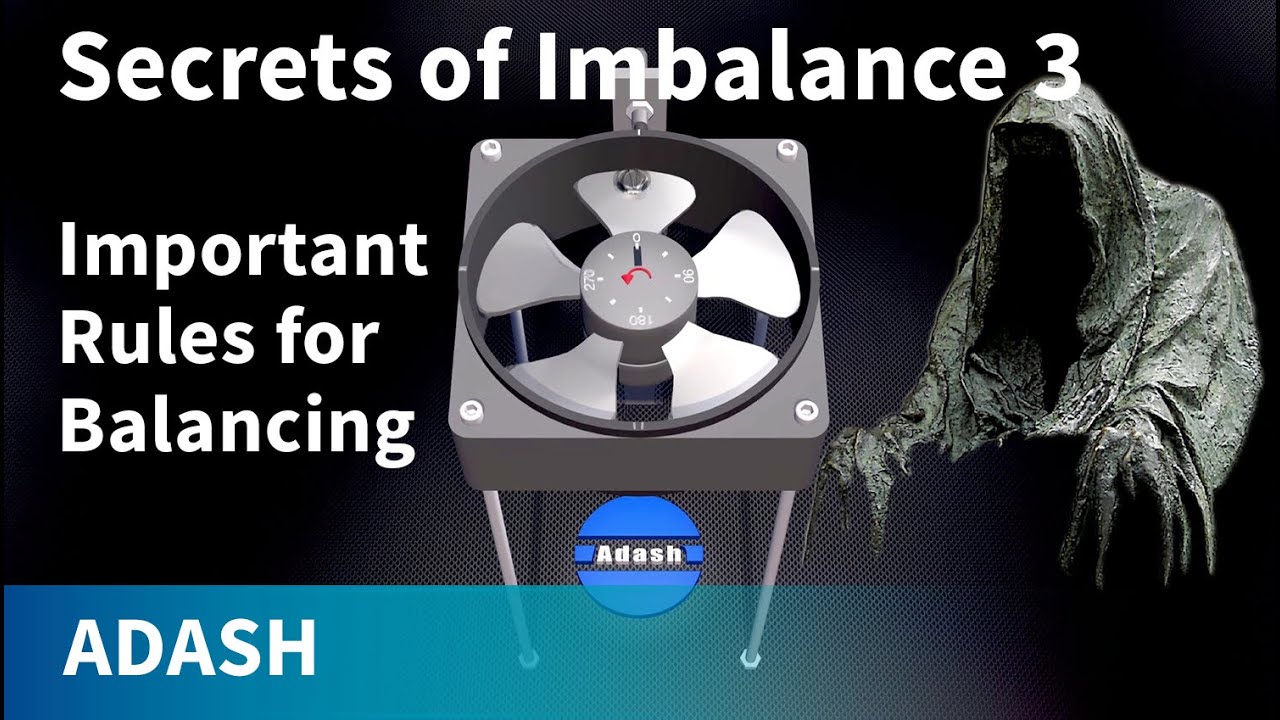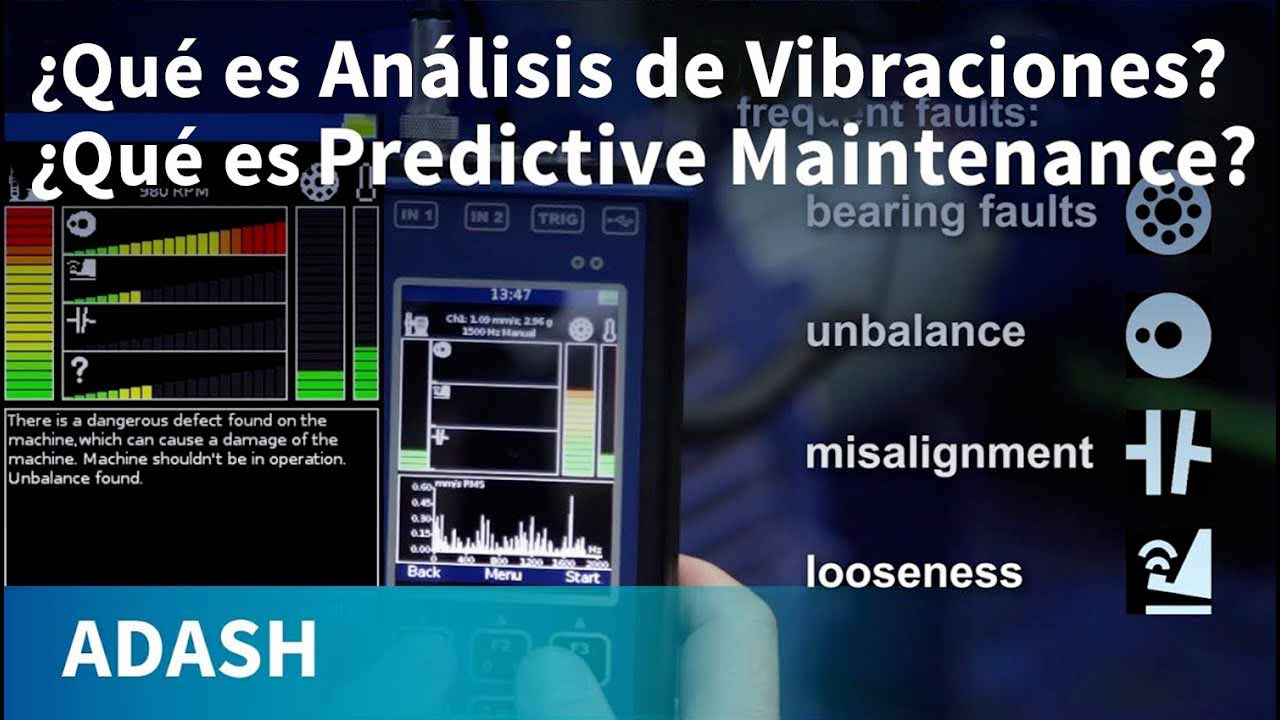Geheimnisse der Unwucht 2
24.09.2021
In diesem Video möchte ich die Beziehung zwischen der Position schwerer Stellen und Vibrationen bei Beschleunigung, Geschwindigkeit und Verschiebung erklären. Das Verständnis davon wird Ihnen bei Ausgleichsarbeiten helfen.
Wir verwenden den Adash VA5-Analysator. Wir messen das Beschleunigungssignal und der Analysator rechnet es in Geschwindigkeits- und Verschiebungssignale um. Wir verwenden auch die APS-Messung. Sie gibt uns die Amplitude und Phase der Geschwindigkeitsfrequenz.
Bei einem negativen Maximum muss die Bewegung anhalten, da die Bewegungsrichtung von unten nach oben geändert werden muss. Ab diesem Punkt beginnt die Aufwärtsbewegung. Es ist die positive Bewegung. Das bedeutet, dass die Geschwindigkeit auch positiv sein muss.
Wenn die Bewegung den Mittelpunkt durchläuft, hat sie die höchste Geschwindigkeit. Sie hat die Geschwindigkeit bis zu diesem Punkt erhöht, das heißt, sie hat beschleunigt. Ab diesem Punkt muss sie die Geschwindigkeit verringern, das heißt, sie muss bremsen. Warum? Es ist klar, dass sie in dieser Zeit anhalten muss. Die Bewegung muss in dieser Zeit die Richtung ändern. Das bedeutet, dass die Geschwindigkeit wieder Null sein muss. In diesem Intervall findet eine Abwärtsbewegung statt. Die Geschwindigkeit ist negativ.
Und die wichtige Frage: Wie findet man die Position des schweren Punkts anhand von Geschwindigkeitsmessungen? Wir wissen, dass der Verschiebungsphasenwert uns genau sagt, wo sich der schwere Punkt befindet. In diesem Beispiel beträgt die Phase null Grad. Das bedeutet, dass sich der schwere Punkt an derselben Position befindet wie das reflektierende Band. Die Geschwindigkeitsphase beträgt 90 Grad. Es ist klar, dass wir die 90 Grad von der Geschwindigkeitsphase abziehen müssen und diese Phase ist der Winkel der Position des schweren Punkts. Wenn wir 90 Grad abziehen, befinden wir uns in derselben Situation wie beim Verschiebungsphasenwert. Bevor ich anfange, über Beschleunigung zu sprechen, sollte ich Ihnen einige Worte über Kraft und Feder sagen. Auf dem Bild ist der Motor mit flexiblem Fundament zu sehen. Er ist auf Federn montiert. Der Motor läuft jetzt nicht. Er befindet sich in Ruheposition oder Nullposition. Ich wende Kraft nach oben an, zum Beispiel durch den Kran. Die Federn dehnen sich und erzeugen die Gegenkraft. Die Kraftgröße ist proportional zur Änderung der Federlänge. Das bedeutet, dass eine größere Dehnung eine größere Gegenkraft erzeugt. Wenn die vom Kran erzeugte positive Kraft verschwindet, bringt die Federkraft minus F den Motor in die Ruheposition zurück. Derselbe Vorgang findet statt, wenn die Feder zusammengedrückt wird. Auch hier bewirkt eine größere Kompression eine größere Gegenkraft der Saiten. Jetzt wenden wir das starre Fundament an. Die Federn werden entfernt und Bolzen verwendet. Die Frage ist: Hat sich etwas geändert? Die Antwort ist nein. Der Bolzen ist auch eine Feder. Aber viel, viel steifer.
Dies ist ein ähnliches Beispiel. Wir haben den Rotor, der sich nicht dreht. Er befindet sich in Ruheposition. Er kann sich nur in vertikaler Richtung bewegen. Wie im letzten Beispiel kann ich die Feder strecken oder zusammendrücken. Wenn die Kraft verschwindet, kehren die Saiten in die Ruheposition zurück.
Jetzt läuft der Rotor. Der schwere Punkt erzeugt die Zentrifugalkraft. An einigen Stellen ist die Kraft groß und streckt oder komprimiert die Feder. An anderen Stellen ist die Gegenkraft der Feder größer und bringt den Rotor in die Ruheposition zurück. Unser Rotor kann sich nur in vertikaler Richtung bewegen. Das bedeutet, dass nur der vertikale Teil der Zentrifugalkraft verwendet wird.
Jetzt verstehen wir ein wenig, was Kraft ist. Sie zieht oder drückt. Die grundlegende physikalische Formel besagt, dass die Kraft gleich der Masse multipliziert mit der Beschleunigung ist. Die Masse ist konstant. Das bedeutet, dass die Beschleunigung direkt proportional zur Kraft ist. Das heißt, wenn wir von Kraft sprechen, sprechen wir von der Beschleunigung.
Die Richtung des Vibrationssensors ist dieselbe wie die Richtung des Tachosensors. Das vereinfacht die Beispiele. Wenn beide Richtungen nicht gleich wären, müssten wir ihren Winkelwert zum endgültigen Phasenwert addieren oder davon abziehen. Ich denke, dass es einfach ist, diese Regel in die Praxis umzusetzen. Bitte verstehen Sie gut, was diese Regel bedeutet. Der Sensor kann an vielen Stellen an der Maschine montiert werden. Es ist uns egal, wo er ist. Die Richtung des Sensors ist wichtig. An einer Stelle kann ich den Sensor in mehreren Richtungen montieren. Jede Richtung erfordert eine andere Position des Tachosensors.
Und die letzte Offenbarung. Sie können mir sagen: Ja, jetzt kann ich die Position der schweren Stelle nach dem ersten Auswuchtdurchlauf abschätzen. Aber was tun mit solchen Informationen? Sie sind sehr nützlich. Sie ermöglichen es Ihnen, die Probemasse auf der gegenüberliegenden Seite zu montieren. Das bedeutet, dass die Vibration im Probelauf abnehmen sollte. Und das ist gut so. Wenn Sie die Probemasse willkürlich montieren, kann die Vibration zunehmen. Und das kann gefährlich sein und die Maschine könnte ernsthaft beschädigt werden. Oder das Steuersystem stoppt die Maschine aufgrund der starken Vibration. Ich freue mich auf Ihre Kommentare. Sie helfen uns bei der Entscheidung, welches Video wir das nächste Mal machen. Also, bis zum nächsten Mal und danke fürs Zuschauen.





